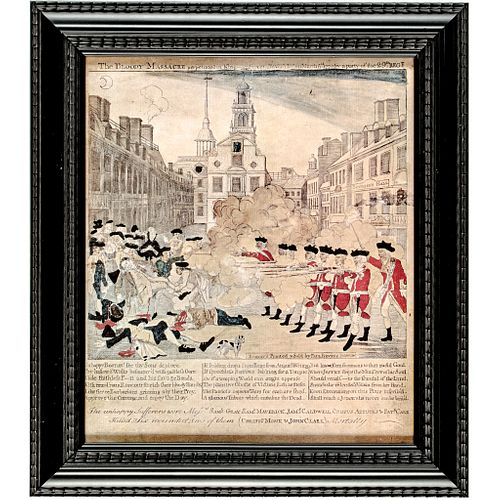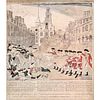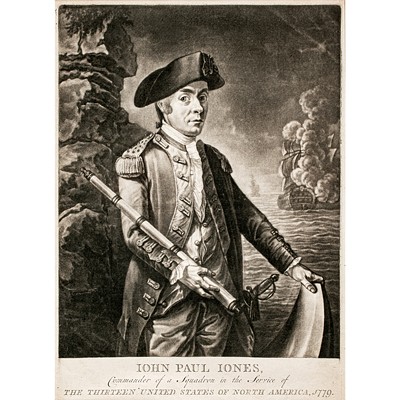Circa 1950 Copy of Paul Reveres Historic Print THE BLOODY MASSACRE... March 5th 1770
Lot 116
Categories
Estimate:
$1,000 - $2,000
Absentee vs Live bid
Two ways to bid:
- Leave a max absentee bid and the platform will bid on your behalf up to your maximum bid during the live auction.
- Bid live during the auction and your bids will be submitted real-time to the auctioneer.
Bid Increments
| Price | Bid Increment |
|---|---|
| $0 | $10 |
| $200 | $20 |
| $300 | $25 |
| $500 | $50 |
| $1,000 | $100 |
| $2,000 | $200 |
| $3,000 | $250 |
| $5,000 | $500 |
| $10,000 | $1,000 |
| $20,000 | $2,000 |
| $30,000 | $2,500 |
| $50,000 | $5,000 |
| $100,000 | $10,000 |
| $200,000 | $20,000 |
| $300,000 | $25,000 |
| $500,000 | $50,000 |
About Auction
By Early American History Auctions
Jan 23, 2021
Set Reminder
2021-01-23 12:00:00
2021-01-23 12:00:00
America/New_York
Bidsquare
Bidsquare : Early American History Auction of Autographs, Americana, Political & Maps
https://www.bidsquare.com/auctions/early-american-history-auctions/early-american-history-auction-of-autographs-americana-political-maps-6311
311 Lots of Rare, Historic Autographs, Americana, Civil War Era, George Washington, Abraham Lincoln, Slavery & Black History, Revolutionary War Era, Colonial America, Federal Period, War of 1812, Colonial Currency, Indian Peace Medals & more... Early American History Auctions auctions@earlyamerican.com
311 Lots of Rare, Historic Autographs, Americana, Civil War Era, George Washington, Abraham Lincoln, Slavery & Black History, Revolutionary War Era, Colonial America, Federal Period, War of 1812, Colonial Currency, Indian Peace Medals & more... Early American History Auctions auctions@earlyamerican.com
- Lot Description
American Revolution
Mid 20th Century Copy of Paul Revere's Historic Print "THE BLOODY MASSACRE... March 5th 1770"
(PAUL REVERE), c. 1950 Mid 20th Century, Full-Color Photostatic Reproduction of Paul Revere's Original Print, "The BLOODY MASSACRE perpetrated in King Street BOSTON on March 5th 1770 by a party of the 29th Regt.", Framed, Choice Mint.
At first glance, this appears to be a genuine hand-colored example of Paul Revere's iconic Original Boston Massacre Print, but closer examination reveals that the image is comprised of halftone dots and that it is a quality reproduction. The drawing is accurate, it follows the Original exactly, and the coloration is consistent with the Originals. Alas, this is a copy that is believed to have been produced circa 1950. By sight, the reprint measures 10.5" x 9" and it has been placed under "Conservation Glass" in a modern, ornate, black wood frame to an overall size of 13.5" x 12". Ex: EAHA Auction, August 28, 2004, in lot 167. Considering the extreme value of Original Paul Revere "Boston Massacre" Prints, recently in January 2019 a nice example sold at a major New York City auction house for $362,500 USD, this is a vastly less expensive, yet an equally historic looking and attractive reproduced version.
Paul Revere (December 21, 1734 Old Style [or January 1, 1735 New Style[ - May 10, 1818) was an American silversmith, engraver, early industrialist, and Patriot in the American Revolution. He is best known for his midnight ride to alert the colonial militia in April 1775 to the approach of British forces before the battles of Lexington and Concord, as dramatized in Henry Wadsworth Longfellow's poem, "Paul Revere's Ride" (1861).
At age 41, Revere was a prosperous, established and prominent Boston silversmith. He had helped organize an intelligence and alarm system to keep watch on the British military. Revere later served as a Massachusetts militia officer, though his service ended after the Penobscot Expedition, one of the most disastrous campaigns of the American Revolutionary War, for which he was absolved of blame.
Following the war, Revere returned to his silversmith trade. He used the profits from his expanding business to finance his work in iron casting, bronze bell and cannon casting, and the forging of copper bolts and spikes. In 1800, he became the first American to successfully roll copper into sheets for use as sheathing on naval vessels.
- Shipping Info
-
Early American provides in-house worldwide shipping. Please contact us directly if you have questions about your specific shipping requirements.
-
- Buyer's Premium



 EUR
EUR CAD
CAD AUD
AUD GBP
GBP MXN
MXN HKD
HKD CNY
CNY MYR
MYR SEK
SEK SGD
SGD CHF
CHF THB
THB












